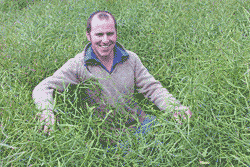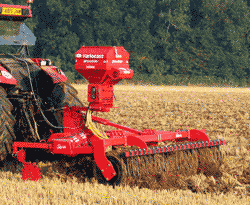One-pass system gives reliable OSR establishment
Some choose to plough, cultivate and drill, some to minimally cultivate and drill and others to just broadcast the seed on the ground – there seems to be no established system for sowing oilseed rape.
It appears to be the one crop most farmers are prepared to take a gamble on by trying establishment methods that push the possibility of success to the limit.
At one end of the scale are the Autocast-style combine header bolt-on systems, which broadcast seed directly on to the stubble and are reported to work in some years and not in others. At the other end are systems that involve ploughing and power harrowing before drilling and pressing.
The ideal probably lies somewhere between the two extremes of doing nothing and doing everything, a workable system that can establish an oilseed crop with a degree of certainty at an acceptable cost. And Charlie Wood, at Twyford, Buckinghamshire, believes he has found the ideal system.
With some of the heaviest clay land most will ever encounter – the London Brick Company used to be nearby – the timing of cultivations and planting has to be precise on this 400ha (1000-acre) farm.
 |
|---|
| Charlie Wood with the oilseed rape (Lioness) planted at 7kg/ha with the five-leg subsoiler and pneumatic seeder unit at the beginning of last September. |
“We grow mainly first wheats and oilseed rape,” says Mr Wood. “And both crops need to be established well first time round – we don’t get second chances on this ground.”
Until last year, fields destined for oilseed rape were cultivated initially with a set of 3.8m wide Simba discs before being given a pass with a McConnel Shakerator and then drilled with an Amazone combination drill.
“It was a lengthy period of operation and one which could be brought to a halt at any stage if the weather turned for the worse,” he says. “It was also an expensive way of establishing oilseed rape and a system that, despite its degree of preparation, could not always guarantee a satisfactory outcome.”
Mr Wood says that while he recognised the need to change, he was undecided on what to change to.
“We needed a system that could get over the ground reasonably quickly, could create a suitable tilth without losing moisture and could plant the seed – preferably in one pass,” he says.
The solution was a 3m, five-leg subsoiler from Opico’s He-Va cultivator range, and one of the company’s pneumatic seeder units bolted on the top to feed five outlets positioned behind each leg.
“The seed outlets did have spread plates on, but we bent them so that they were vertical to make the seed fall into the area moved by the tines. Our thinking was that the subsoiler would provide not only a row of fresh soil for the seed to be placed in before it was pressed, but there would also be a good element of drainage if it became over-wet.”
Seed is stored in a 50kg-capacity hopper and meted out by landwheel into airflow generated by an electric fan.
“We were a bit concerned when we first tried it. The ground pulled up rough, but most of the seed found its way to make contact with warm, moist soil and germinated well as a result. I think it is important to roll the fields just to make sure the seed is making soil contact.”
 |
|---|
| The Opico He-Va/seeder unit in work. Charlie Wood says he was a bit concerned initially by the appearance of the field, but the seed clearly made contact with moist soil created by the subsoiler legs. |
Seed rate was 7kg/ha and, as an insurance against slug damage, the seed had slug pellets mixed with it. An MF 8250 was used to pull the cultivator, which was set to work at a depth of about 30cm (12in), its action also offering benefits for succeeding crops.
“We managed to get over about five acres an hour, which meant we could get up to 50 acres drilled on most days,” he says. “But for next year we are going to use a 5m, seven-leg version, which will be put behind an MF 8480, a combination which should increase output significantly. We can still use the same seeder unit with more outlets.”
Looking at the crops sown by the system, you see flourishing plants that have strong, deep roots, deeper than those that have been drilled conventionally. However, the proof of the job will be at harvest when the yield is known, but for now, with the pods filling out, the crops look well.
“I am hopeful that we now have a system that will enable us to establish oilseed rape in a wide variety of conditions and not have to concern ourselves unduly with how dry or wet it is,” he says.

